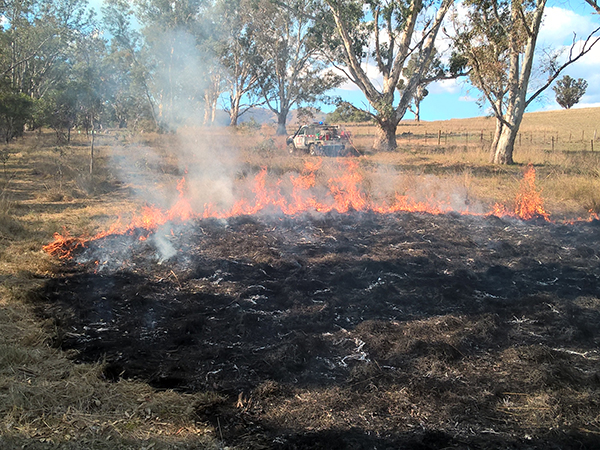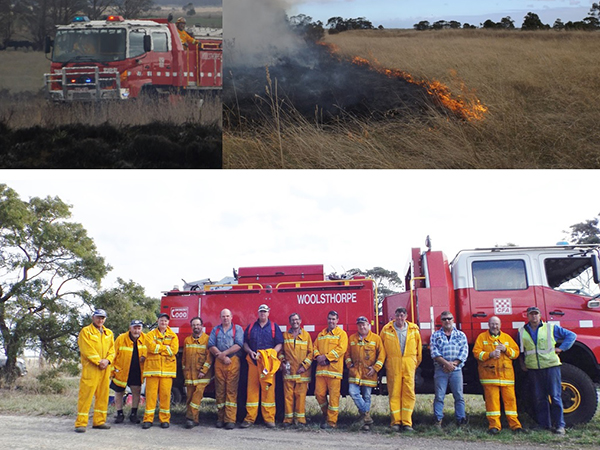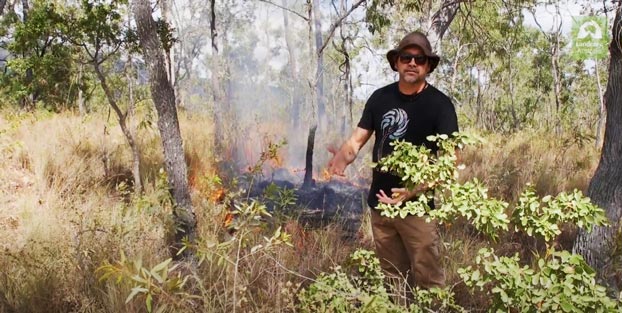From 1788 to 2019: using fire to ensure plants and animal habitats flourish
By Valerie Woods, Landcare Australia

The Upper Goulburn Landcare Network, with the assistance of the Limestone Country Fire Authority carried out three ecological burns.
In his plenary address at the 2018 National Landcare Conference, Australian National University emeritus professor Bill Gammage, spoke about how, at the time Europeans arrived in Australia in 1788, Aborigines used fire and no fire to ensure that every plant and animal had a habitat in which they could flourish.
He sketched what we might learn from their management, while noting how in important ways, the land has changed since 1788.
According to Professor Gammage, “In 1788, the Indigenous people used fire and no fire to distribute plants,
and plant distribution to locate animals, birds, reptiles and insects. With fire and no fire people associated plant communities, grass with trees for example, to give plants and animals ideal habitats, making them abundant, then carefully distributed those habitats, making plants and animals convenient and predictable. They could make paddocks without fences, because most Australian plants tolerate fire, the only large predators to disturb prey concentrated by fire were people, and people had a philosophy which protected every species.”
Have we learned from these traditional indigenous practices and are they still relevant as a fuel management tool in 2019? The answer is certainly yes.
Two VicTrack funded projects in partnership with Landcare Australia are excellent examples of recent ecological burns. These burns, on former rail land in Victoria, successfully helped control weeds, promote new growth and increase native species diversity in high-conservation value grassland areas.
Using ecological burning to encourage new growth along the Great Victorian Trail
The VicTrack-funded Pedalling the Great Victorian Rail Trail with Landcare project undertaken by the Upper Goulburn Landcare Network (UGLN) in Victoria, focusses on controlling woody and noxious weeds in areas of biodiversity significance along the rail trail, as well as planting native plants. Weed removal and revegetation to in-fill gaps and understorey diversity in the natural vegetation has ensured the improved condition and connectivity of the native vegetation.
Revegetating degraded sections of the disused railway land by planting 2,000 local indigenous trees and shrubs and installing 40 nest boxes built by local high school students were two of the tactics used in this project.
Employing ecological burns was a third significant tactic to help control weeds, promote new growth and increase native species diversity in high-conservation value grassland areas of the rail trail around Limestone and Cheviot.
The UGLN have been liaising with the Shane Monk from Taungurung Aboriginal Corporation and plan to involve him and the Taungurung community in future burns along the rail trail.
“There are huge benefits with having the local Aboriginal people involved. Fire is such an important part of the Taungurung heritage and it is the way Shane’s ancestors managed our grasslands. We’re all learning together, CFA [Country Fire Authority], Landcare and the Taungurung,” Chris Cobern, Upper Goulburn Landcare Network Landcare coordinator and project officer said.
The ecological burning of these grasslands has encouraged new growth and improved the health of the native grasses. Burning is especially important for kangaroo grass tussocks as they can die-off when the plants are smothered out by dead plant material. These tussocks are important habitat of the endangered striped legless lizard found in the region. As Bill Gammage shared in his address, the fire can also help regenerate native herbs, groundcovers and wildflowers present in these special areas.
As a result of undertaking three successful burns in 2018, the UGLN developed valuable partnerships with two local CFA Brigades. Chris emphasises the crucial role local CFA brigades have in controlled burns. Local council staff in charge of issuing fire permits feel more comfortable knowing the CFA are involved.
According to Chris, “The ecological burning component involved a lot more organisation than the other components of the project. “However, now we’ve done it we know what to expect next time.”
The Green Line project uses ecological burn as an environmental management tool
The Green Line is another Landcare Australia project in partnership with VicTrack which recently undertook an ecological burn as an environmental management tool. The Basalt to Bay Landcare Network manages this planned biodiversity corridor project, which aims to protect and enhance the biodiversity and habitat connectivity of the former Koroit to Minhamite Railway Line in western Victoria.
This reserve stretches 37 kilometres, encompassing four listed endangered ecological vegetation classes (EVC), as well as numerous rare and endangered species. At an average of 30 metres wide, it is always competing with edge effects of adjoining farming, like weed incursions. It also suffers from a lack of native fauna processes, such as browsing kangaroos and digging bandicoots.

The team from Woolsthorpe Country Fire Authority assisted with the ecological burn on the Green Line project.
Having endangered EVCs meant that no graded bare earth breaks could be built, meaning an autumn burn with an experienced roadside burning brigade was chosen.
In partnership with the local CFA, Basalt to Bay Landcare Network at Warrong Siding used ‘wet breaks’ instead of graded earth breaks to limit the accidental spread of the fire. This drastically reduced the burn’s impact, while also helping to reduce follow-up weed invasion.
The burn stimulated the germination of a range of grassland plants that were thought extinct from the local area. Four trucks, one ute, 15 volunteer fire specialists and a donated tanker of water were employed for this grassland burn.
Basalt to Bay Landcare Network facilitator Lisette Mill said, “We and VicTrack need the CFA brigades for their expertise and because they are the farmers beside our project.
“Having them invested in working together means more positive outcomes follow.”
One outcome is a stronger relationship with the CFA to support local traditional owners to connect with the sites through fire and bush foods. The CFA has a full-time Indigenous engagement officer who is assisting in planning a 2020 indigenous burn in part of The Green Line where there is a newly registered scar tree.
“Our local Indigenous clans haven’t had places to practice or train on Crown Land that isn’t a National Park.” Lisette said. “The Green Line gives many a venue to blend burn styles and burn resources. Bringing people together to preserve the natural assets, encourage training and generate knowledge, awareness, and partnerships is the future for this project. It’s the Landcare way.”
According to Landcare Australia environmental projects manager Rowan Ewing there is a shift in the way Australians look at and manage our landscapes, particularly where fire is concerned.
“These projects undertaken by the Upper Goulburn and the Basalt to Bay Landcare Networks, where Landcare is able to reach out and bring a broad range of the community together to listen, plan and manage the areas important to them, are great examples of the positive role Landcare plays in towns and communities across Australia,” he said.
Cultural Land Management
First Nations Peoples connection to Country provides a rich source of knowledge for better land and water management, and fire management policies. With our stakeholders, Landcare Australia has made available articles, videos and other resources to help landcarers and land managers appropriately integrate First Nations Peoples knowledge and more recent knowledge, into building ecological and community resilience.
Victor Steffenson performing a cultural burn for Landcare Australia’s Fire and Water: Healing Country, Healing People Video.




